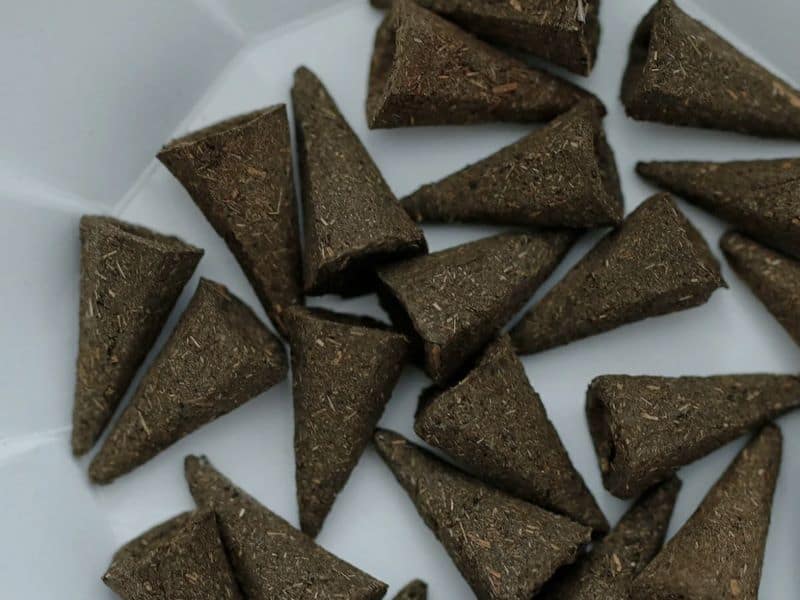Prior to coming across this question, I would not have imagined it to be true.
Not all incense is made of dung but there are some companies that mix cow dung into their incense paste recipe. They exist in the form of incense cups, sticks, and cakes and are said to kill germs in the air.
In this post I explain why cow dung incense is used and share more about its benefits as well as where you can find it if it’s something you’d like to try.

What Is Regular Incense Made Of?
Most commonly, natural incense is made of wood and resins that’ve been ground into powder form, along with a mixture of herbs, flower petals, seeds, spices, and other organic matter.
Fragrance is often added in the form of essential oils and sometimes fragrance oils. The entire mixture is bound together by a natural paste, like gum arabic.
What Is Dung Incense?
Believe it or not, in some cases cow dung is added to the ingredients listed in the last section.
Actually, wet or dry cow dung is the primary ingredient in dung incense, and then the remaining powders and fragrances are added to the mixture. But in addition to resins and wood powders, all of the dung incense recipes I’ve come across also incorporate ghee and coconut oil.
Dung incense can be used as part of ritualistic ceremonies, meditation, and devotions practiced by Hindus, in a process referred to as puja. These various forms of worship can be carried out in a temple or inside a person’s home by religious leaders or laypersons. Dung incense helps set the atmosphere and cleanse the space in preparation for these ceremonies.
The process of making this incense using wet dung is demonstrated in the video below. While there are no subtitles available, the company lists all ingredients used in this post on their website. I’ve also included them below the video.
While the ingredients for dung incense won’t be the same across all companies, I thought it interesting to take a closer look at what Amodiva mixes together. Here’s their list of ingredients:
Gir cow dung: Gir cattle are a premium breed native to India. They are often crossbred with other cattle varieties in order to improve those species.
Googal: Also guggul or goggal is a fragrant resin that has anti-inflammatory properties.
Luban: Which means frankincense in the Urdu language, is tree resin.
Raal: Aromatic anti-inflammatory, anti-bacterial gum extract from the Sal tree.
Desi ghee: Desi cows are also native to India and Desi ghee is made from their milk butter.
Coconut oil: Possibly a carrier oil to enhance fragrance.
Rice: Likely in powder form; helps intensify incense aroma.
Bhimsaini kapur: Aromatic camphor crystals
Only natural ingredients are used and all of the ingredients are blended by hand. There are many benefits to luban (frankincense), as mentioned in this article. Also, in this federal government clinical trial proposal, they mention that historically, luban has been found to be anti-inflammatory and anti-bacterial. This is partly what makes dung incense both physically and symbolically cleansing.
Since the demonstrated incense are the dhoop form, there isn’t a bamboo stick core. Instead, the mass of ingredients is compacted and pushed through a tube before they’re left to dry. This particular brand is dried in the sun.
Amodiva indicates that this incense helps remove stress from your space. It can also be used as an insect repellant. It attracts the divine and removes negative energy.
Can I Make Incense from Dung?
Alternatively called gobar, cow dung is also rich in minerals and antibacterial properties that help cleanse the air and fight germs.
More and more people enjoy making their own incense. And It is possible to make your own dung incense. There are videos and websites that list ingredients used by proportion. You can start with their recipes and then tweak them to create your own scents.
Here is one simple recipe and a video for a traditional approach to making cow dung dhoop sticks.
Amongst all of the recipes, I notice some overlapping ingredients:
- Cow dung cakes
- These are dried cow dung cakes and unless you are in India and can source wet cow dung directly, I’m guessing this is the best format that’s available. If you have access to a farm, it’s also possible to use the wet dung but you have to be mindful of what the cows have been fed. Indian cows are fed a high-quality herbivore diet. In some other places, their diets are a combination of high and low quality feed. Since you will inhale the incense you burn, it’s best to use the dried Indian dung cakes.
- What’s super helpful about these cakes in particular is that it’s made with Panchgavya. This means that it already has ghee in it along with three additional ingredients.
- Bhimseni camphor
- Additional resins
- Particularly benzoin and frankincense
- Wood powder
- This one is sandalwood
Lastly, you would need a large mortar and pestle to properly grind all of the ingredients together. Once ground, coconut oil and water as needed to make a thick paste.
If you don’t have a cylinder mold to press the mixture through as seen in the videos, you might consider making cones instead. You can either shape them by hand, or use an incense cone mold described in this post.
Incense Made from Cow Dung
DIY dung incense may isn’t appealing to everyone. Indians who practice Hinduism view cows as sacred. Their dung, milk, butter, urine, and curd (together, making Panchgavya) are equally esteemed and considered great gifts. So to them, making dung patties and incense is an honor.
If you respect the symbolic meaning of dung incense but would prefer to skip over the hands-on aspect of it, you can order pre-made dung incense.
I’ve found them in cup and stick formats. Here are some examples:
GauKriti Hawan Kund Incense Dhoop Cups
No products found.
Even the packaging is made using cow dung and urine. And the dhoop cups themselves are 100% natural. Talk about an eco-friendly incense product.
These cups can be used as part of your daily prayer ritual to promote positivity and celebrate joy. Tulsi, Hindi holy basil is some of the plant matter that has been incorporated into this dung incense. In total, a combination of 25 herbs and woods were ground into powder to be mixed in with the cow dung.
Two rather thick, well-made burning stands are included with this box of 24 dung whoop cups.
Satvik Cow Dung & Resin Incense Cups
No products found.
These dhoop cup ingredients include the googal (also guggle) and luban (or, loban, frankincense) resins mentioned earlier, along with natural flowers.
Includes two thin metal burner plates.
GauKriti Cow Dung Incense Sticks
No products found.
For the last example, we have sticks. These are thicker than Indian incense sticks made using a bamboo core, making them dhoop incense sticks. If you don’t have a holder for them, sitting them inside a bowl filled with sand or rice would work just as well.
Five packets of 20 sticks are included, for a total of 100 dung incense sticks that burn for 20 to 30 minutes each.
In Conclusion
While less common in the Western world, dung incense does exist and is used regularly as part of religious rituals and home cleansing in India. People who have traveled to India find the scent to trigger pleasant memories.
If you choose to burn incense made of dung, and you live in an apartment and/or have roommates, you might want to consider how the smell will affect everyone involved.
Even with all of the resins mixed in, you’ll still smell the dung. So this is a scent you’ll want to either burn when at home alone or with individuals who also enjoy the peculiar fragrance.
But with that said, the only way to experience dung incense is to give it a try. Let me know what you think.
Read more:
